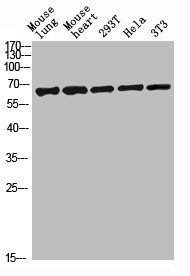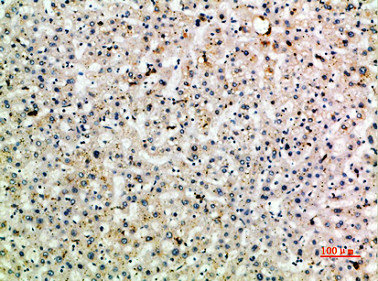CLEC4M Antibody
-
中文名称:CLEC4M兔多克隆抗体
-
货号:CSB-PA618551
-
规格:¥880
-
图片:
-
其他:
产品详情
-
Uniprot No.:Q9H2X3
-
基因名:CLEC4M
-
别名:C type lectin domain family 4; member M antibody; C-type lectin domain family 4 member M antibody; CD209 antigen like antibody; CD209 antigen like protein 1 antibody; CD209 antigen-like protein 1 antibody; CD209L antibody; CD209L1 antibody; CD299 antibody; CD299 antigen antibody; CLC4M_HUMAN antibody; CLEC4M antibody; DC SIGN related protein antibody; DC SIGN2 antibody; DC SIGNR antibody; DC-SIGN-related protein antibody; DC-SIGN2 antibody; DC-SIGNR antibody; DCSIGN related protein antibody; DCSIGNR antibody; Dendritic cell-specific ICAM-3-grabbing non-integrin 2 antibody; HP10347 antibody; L SIGN antibody; L-SIGN antibody; Liver/lymph node specific ICAM3 grabbing nonintegrin antibody; Liver/lymph node-specific ICAM-3-grabbing non-integrin antibody; LSIGN antibody; Mannose binding C type lectin DC SIGNR antibody; MGC129964 antibody; MGC47866 antibody
-
宿主:Rabbit
-
反应种属:Human,Mouse,Rat
-
免疫原:Synthetic peptide from Human protein at AA range: 271-320
-
免疫原种属:Homo sapiens (Human)
-
标记方式:Non-conjugated
-
纯化方式:The antibody was affinity-purified from rabbit serum by affinity-chromatography using specific immunogen.
-
浓度:It differs from different batches. Please contact us to confirm it.
-
保存缓冲液:PBS, pH 7.4, containing 0.02% sodium azide as Preservative and 50% Glycerol.
-
产品提供形式:Liquid
-
应用范围:WB, IHC, ELISA
-
推荐稀释比:
Application Recommended Dilution WB 1:500-1:2000 IHC 1:100-1:300 ELISA 1:20000 -
Protocols:
-
储存条件:Upon receipt, store at -20°C or -80°C. Avoid repeated freeze.
-
货期:Basically, we can dispatch the products out in 1-3 working days after receiving your orders. Delivery time maybe differs from different purchasing way or location, please kindly consult your local distributors for specific delivery time.
相关产品
靶点详情
-
功能:Probable pathogen-recognition receptor involved in peripheral immune surveillance in liver. May mediate the endocytosis of pathogens which are subsequently degraded in lysosomal compartments. Is a receptor for ICAM3, probably by binding to mannose-like carbohydrates.; (Microbial infection) Acts as an attachment receptor for Ebolavirus.; (Microbial infection) Acts as an attachment receptor for Hepatitis C virus.; (Microbial infection) Acts as an attachment receptor for HIV-1.; (Microbial infection) Acts as an attachment receptor for Human coronavirus 229E.; (Microbial infection) Acts as an attachment receptor for Human cytomegalovirus/HHV-5.; (Microbial infection) Acts as an attachment receptor for Influenzavirus.; (Microbial infection) Acts as an attachment receptor for SARS-CoV.; (Microbial infection) Acts as an attachment receptor for West-nile virus.; (Microbial infection) Acts as an attachment receptor for Japanese encephalitis virus.; (Microbial infection) Acts as an attachment receptor for Marburg virus glycoprotein.; (Microbial infection) Recognition of M.bovis by dendritic cells may occur partially via this molecule.
-
基因功能参考文献:
- heterozygous VNTR genotypes 57 and 67 of CLEC4M were highly enriched and are the most likely mechanism through which CLEC4M contributes to disease in the Swedish type 1 VWD population PMID: 29389944
- DC-SIGNR promoted gastric cancer liver metastasis mediated with HNRNPKP2 which expression was regulated by STAT5A. And HNRNPKP2 decreased the expression of downstream target gene CXCR4. These findings indicated potential therapeutic candidates for gastric cancer liver metastasis. PMID: 28403883
- the neck domains of DC-SIGN and DC-SIGNR can contribute to the different functions of these receptors by presenting the sugar-binding sites in different contexts. PMID: 27859859
- Together, these studies confirm a role for C-type lectin receptors DC-SIGN and L-SIGN as attachment factors and entry receptors for human metapneumovirus infection. PMID: 27334579
- DC-SIGNR VNTR and DC-SIGN VNTR were not associated with the risk of pulmonary tuberculosis in a sample of Iranian population PMID: 27309478
- CD209L variation may influence susceptibility to HIV-1, response to treatment, and disease progression. PMID: 25656622
- DC-SIGNR expression in peripheral blood mononuclear cells was higher in HIV-1-infected patients, and its positive correlation with viral load and negative with CD4+ T cells counts suggest a potential role of DC-SIGNR in HIV-1 infection. PMID: 26313015
- Study demonstrated that serum levels of DC-SIGNR in lung cancer patients were significantly lower than those in healthy individuals, and correlated significantly with brain metastasis and serum NK cells percentage. PMID: 26150177
- Genetic variations in STXBP5 and CLEC4M are associated with VWF level variation in type 1, but not in type 2 von Willebrand disease. PMID: 25832887
- of an association between CD209 and CD209L polymorphisms and tuberculosis development in a Brazilian population PMID: 24874302
- DC-SIGN and DC-SIGNR are blood-based molecular markers that can potentially be used for the diagnosis of early stage patients PMID: 25504222
- Japanese encephalitis virus infected cells through three virus receptors: DC-SIGN, DC-SIGNR and LSECtin. PMID: 24623090
- The results indicate that neck region polymorphism of L-SIGN can influence the outcome of HCV infection and the four-tandem repeat is associated with clearance of HCV infection. PMID: 24283933
- CLEC4M and CD81 both are still crucial for hepatitis C virus entry into hepatocytes. PMID: 24965233
- The CLEC4M carbohydrate recognition domain rapidly and reversibly releases glycan ligands and Ca(2+) at reduced pH. PMID: 24976257
- these results provide evidence that hDC- and hL-SIGN can mediate the entry of Junin virus into cells, and may play an important role in virus infection and dissemination in the host. PMID: 24183720
- Up-regulation of Raf-MEK-ERK pathway by HCV E2 via L-SIGN provides new insights into signaling cascade of L-SIGN PMID: 23292357
- Our findings suggested that DC-SIGNR neck region VNTR polymorphism was not directly associated with hosts' predisposition for HIV-1 infection and not associated with the HIV-1 routes of infection. PMID: 23602836
- DC-SIGNR has a role in expression of lactic acid dehydrogenase and beta2-microglobulin in non-Hodgkin lymphoma PMID: 23859015
- genetic polymorphism is associated with HIV-1 infection PMID: 23354840
- Variable number of tandem repeats in CLEC4M is associated with type 1 von Willebrand disease. PMID: 23529928
- Both K3 and K5 preferentially associate with DC-SIGN and DC-SIGNR, mediating their ubiquitylation and degradation. PMID: 23460925
- Polymorphisms in DC-SIGN and L-SIGN genes are associated with HIV-1 vertical transmission in a Northeastern Brazilian population. PMID: 22902397
- analysis of attachment factor DC-SIGNR on cells in neutralization studies failed to identify a correlation between DC-SIGNR expression and antibody-mediated protection; studies suggest cellular attachment factor expression is not a significant contributor to potency of neutralizing antibodies to flaviviruses PMID: 23312596
- VNTR polymorphism of the DC-SIGNR gene is associated with a moderate effect on host susceptibility to HIV-1 infection, similar to CCR5 gene deletion PMID: 22957026
- Findings do not support the hypothesis that the origin of the variable number tandem repeat (VNTR} alleles of CLEC4M were arisen by independent (separate) mutation events. PMID: 22279577
- data demonstrate that the signaling events mediated by RSV G interactions with DC/L-SIGN are immunomodulatory and diminish DC activation, which may limit induction of RSV-specific immunity PMID: 22090124
- There were multiple genotypes of the gene DC-SIGNR in the pregnant women infected with HBV. PMID: 22338216
- Upon binding to membrane-anchored ligand, DC-SIGNR undergoes a conformational change similar to that previously observed for DC-SIGN. PMID: 21650186
- Together, these data indicate that human C-type lectins (DC-SIGN and L-SIGN) can mediate attachment and entry of influenza viruses independently of cell surface sialic acid. PMID: 21191006
- 9/5 genotype distribution frequency of DC-SIGNR's exon 4 in patients with hepatitis C is significantly higher and may be associated with HCV infection susceptibility. PMID: 18171520
- these results suggest that the variation of the tested DC-SIGNR genotypes affects the efficacy of HIV-1 trans-infection by affecting the amounts of the protein expressed on the cell surface. PMID: 20152818
- Our study indicated that there was absence of association between the neck region polymorphism of DC-SIGNR and longevity in Han Chinese population PMID: 20003397
- DC-SIGNR plays a crucial role in MTCT of HIV-1 and impaired placental DC-SIGNR expression increases risk of transmission PMID: 19809496
- DC-SIGNR was mainly expressed in the membrane and plasm in placental trophoblast cells. PMID: 20108443
- determinants in DC-SIGN necessary for HIV-1 transmission and the differences between DC-SIGN and L-SIGN that affect HIV-1 interactions PMID: 19833723
- Crystal structures of carbohydrate-recognition domains of DC-SIGNR bound to oligosaccharide, in combination with binding studies, reveal that it selectively recognizes endogenous high-mannose oligosaccharides PMID: 11739956
- mediates cellular entry by Ebola virus in cis and in trans PMID: 12050398
- reasons underlying the restricted distribution of DC-SIGNR; and expression in relation to HIV entry receptors PMID: 12152166
- Review. This article reviews the interaction of DC-SIGN & DC-SIGNR with HIV and Ebola & discusses the mechanism of DC-SIGN-mediated viral transmission. PMID: 12223058
- the influx or proliferation of DC-SIGN+ immature and mature DCs and L-SIGN+ cells is dynamically regulated PMID: 15111305
- data demonstrate for the first time that lectins DC-SIGN and L-SIGN differ in their carbohydrate binding profiles PMID: 15184372
- largely expressed on endothelial cells in liver sinusoids; results demonstrate that hepatitis C pseudoviruses captured by L-SIGN+ or DC-SIGN+ cells efficiently transinfect adjacent human liver cells PMID: 15371595
- can serve as an alternative receptor for SARS coronavirus PMID: 15496474
- crystal forms of truncated DC-SIGNR comprising two neck repeats and the carbohydrate-recognition domain reveal that the CRDs are flexibly linked to the neck, which contains alpha-helical segments interspersed with non-helical regions PMID: 15509576
- crystal structure of DC-SIGNR with its last repeat region PMID: 15784257
- DC-SIGNR, in addition to DC-SIGN, should be considered as a cofactor in sexual HIV-1 transmission; soluble isoforms, in particular, may modulate the efficiency of viral transmission and dissemination. PMID: 15812562
- A change in the number of DC-SIGN-related (DC-SIGNR) repeats may influence its normal functions as well as its binding capacity to viral and nonviral pathogens. PMID: 16061998
- genetic risk association study shows that individuals homozygous for CLEC4M tandem repeats are less susceptible to SARS infection. PMID: 16369534
- Recognizes pathogens and contributes to innate immunity. PMID: 16386217
显示更多
收起更多
-
亚细胞定位:[Isoform 1]: Cell membrane; Single-pass type II membrane protein.; [Isoform 2]: Cell membrane; Single-pass type II membrane protein.; [Isoform 3]: Cell membrane; Single-pass type II membrane protein.; [Isoform 5]: Secreted.; [Isoform 6]: Secreted.; [Isoform 7]: Secreted.; [Isoform 10]: Secreted.
-
组织特异性:Predominantly highly expressed in liver sinusoidal endothelial cells and in lymph node. Found in placental endothelium but not in macrophages. Expressed in type II alveolar cells and lung endothelial cells.
-
数据库链接:
HGNC: 13523
OMIM: 605872
KEGG: hsa:10332
STRING: 9606.ENSP00000316228
UniGene: Hs.421437
Most popular with customers
-
-
YWHAB Recombinant Monoclonal Antibody
Applications: ELISA, WB, IF, FC
Species Reactivity: Human, Mouse, Rat
-
Phospho-YAP1 (S127) Recombinant Monoclonal Antibody
Applications: ELISA, WB, IHC
Species Reactivity: Human
-
-
-
-
-






















